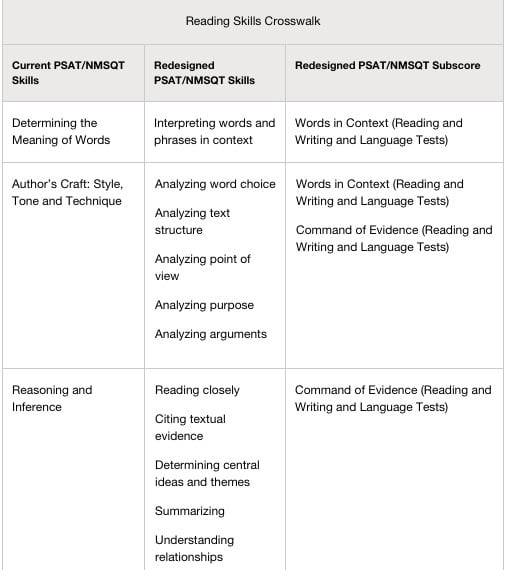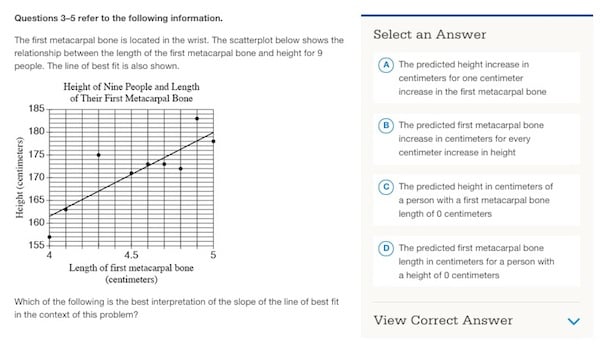
If you're a high school student planning on taking the PSAT, you'll be taking the redesigned PSAT. This new version of the test started in October 2015 was administered to all students across the country.
We'll let you know all about the PSAT format, scoring, and content and what you need to know to be prepared. Not only is the 2015 PSAT an important step in prepping for the SAT, but it also qualifies you for National Merit distinctions and scholarships.
Let's dive into the changes in format, scoring, and content being made to the redesigned PSAT and what these changes mean for your test prep.
NOTE: In 2023, the PSAT became fully digital and debuted a new, shorter format. Learn all about the changes and what to expect from the current PSAT here!
Changes in Format
The new, redesigned PSAT is 35 minutes longer than the old PSAT. It clocks in at 2 hours and 45 minutes, rather than 2 hours and 10 minutes.
Instead of five multiple-choice answers, the PSAT now offers only four. This means you have a better chance of getting the answer right if you guess!
The following chart breaks down the time and number of questions per section:
| Section | Time | Number of Questions |
| Reading | 60 minutes | 48 questions |
| Writing and Language | 35 minutes | 44 questions |
| Math | 70 minutes | 47 questions |
| Total | 165 minutes | 139 questions |
What Format Changes in the New PSAT Mean for Your Prep
The new test is longer, so train your focus. Since the test is still pretty new, there aren't a lot of official practice tests to take. So far, College Board has come out with two official sample PSATs, which you can download and score. Make sure to take note of the changes between this test and older versions.
New PSAT Practice Test 1 - Answer Explanations - Score Your Test
New PSAT Practice Test 2 - Answer Explanations - Score Your Test
Since having only two practice tests gives you limited options, it's also a good idea to use older practice tests. If you are practicing with full-length old practice tests, give yourself an extra section to practice test-taking for that longer chunk of time. As you practice, take note of your energy and attention. Take short breaks and anything else you need to keep focus for that amount of time.
The new PSAT also closely resembles the new SAT, which was first administered in March of 2016. The two tests have very similar content, format, and even scoring. Because of this, you can also use these 10 practice tests for the new SAT to prep, while still keeping an eye out for any differences between the new PSAT and new SAT. (The College Board no longer includes tests 2 and 4 on its website, but you can still access them using the links below.)
New SAT Practice Test 1 - Answer Key
New SAT Practice Test 2 - Answer Key
New SAT Practice Test 3 - Answer Key
New SAT Practice Test 4 - Answer Key
New SAT Practice Test 5 - Answer Key
New SAT Practice Test 6 - Answer Key
New SAT Practice Test 7 - Answer Key
New SAT Practice Test 8 - Answer Key
New SAT Practice Test 9 - Answer Key
New SAT Practice Test 10 - Answer Key
The new scoring system on the PSAT is designed to help you predict your SAT score. Below I'll explain the changes in the scoring system for both the new PSAT and new SAT and how you can incorporate this awareness into your studying.
Changes in Scoring
The redesigned PSAT is scored on a scaled between 320 and 1520. You can score on a range from 160 to 760 for Math and 160 to 760 for Evidence-Based Reading and Writing. In addition to these section scores, your score report will also tell you subscores for Math, Reading, and Writing and Language between 8 and 38. This will give you a sense of which sections you're best at and where you need improvement. Unlike the old PSAT, the redesigned PSAT gives no penalties for wrong answers.
The SAT returned to the 1600 scoring system it used back in the day, before 2005. It now has a maximum composite score of 800 for Math and 800 for Evidence-Based Reading and Writing combined. As I mentioned above, your PSAT score is meant to predict your SAT score.
The PSAT scale doesn't go up to 1600 exactly since the SAT is a more difficult test than the PSAT. While a 1300 on the PSAT suggests you might score around a 1300 on the SAT, a perfect PSAT score doesn't necessarily guarantee perfection on the SAT.
The two scoring scales coincide with one another, but the PSAT is shifted down to account for its differences in difficulty level. Keep this discrepancy in mind when interpreting your PSAT scores from your practice tests and the official test itself.
What Scoring Changes in the Redesigned PSAT Mean for Your Prep
Because they eliminated the wrong answer penalty, you don't have to devise a strategy anymore for which questions to guess on and which to leave blank. Give all of them your best guess, even if you are unsure. If you leave any blank, save enough time at the end of each section to bubble in all your answers.
When you're taking a practice test, make sure to mark which ones are random guesses so you can review them when you're finished. To make the most out of your practice tests, you want to really analyze why you missed a question and what you need to do—review content, work at a faster pace, etc.—to ace that question type the next time.
Since the National Merit Scholarship Corporation is considering your composite score, rather than your section scores, all sections are important for qualifying for National Merit Semifinalist, Finalist, and scholarships.

Changes in Content
The changes that were made to the content of the PSAT match the revisions to the SAT. Overall, the content is more evidence- and context-based, featuring real world scenarios and data analysis. Emphasized skills include depth of analysis, interpretation of a word or idea in context, and multi-step problem solving. Check out the "Skills Crosswalk" for all three sections on College Board.

Gone are the days of studying long lists of obscure vocabulary—the new PSAT (and SAT) tests that you understand the meaning and connotation of a word within the context of a passage. Similarly, grammar questions ask you to revise sentences within the context of passages, not as stand-alone sentences.
All of the sections will include graphs and charts to test your ability to interpret, describe, and represent data visually or in words. The following example is taken from College Board's New PSAT Sample Questions for the math section.

Math questions also include multi-step grid-in word problems. They are going to focus more on algebra and data analysis and less on geometry. The geometry problems that are still there ask you to solve problems involving area, volume, or line, angle, and triangle theorems.
What This Means for Your Prep
Focus on sharpening your skills of problem-solving, data interpretation, and understanding grammar and vocabulary through context. These skills are more connected to what you learn in class and real life. You can develop them through reading and writing widely and often, as well as by paying attention to data representation and analysis in your math and science classes.
When you're reading, take notes on the work's structure and organization. Consider the passage's theme, tone, style, etc. and make sure you can point to specific lines that support your ideas.
Get a sense of the various connotations of words in different contexts, rather than memorizing lists of vocabulary. For example, "brilliant" may mean exceptionally smart when describing a person, but it suggests bright and vivid when describing a color.
Many of the skills and knowledge being tested remain the same from the old PSAT—understanding of literary terms and elements, depth of analysis and interpretation, working knowledge of various mathematical concepts.
The new PSAT asks you to go one step further: to back up your answer with evidence, whether it is from a passage or chart, and to understand the relationships among words and numbers.
Don't stop here: check out our collection of free practice questions and full-length tests for the PSAT, plus learn more about how to use old practice tests and material to prep effectively for the new PSAT.
PSAT Comparison Chart
Below is a chart comparing key points for the old version of the PSAT and the new version of the exam. You can use this to quickly see some of the most important differences between the two tests.
| Former PSAT | New PSAT | |
| Total Scoring Scale | 60-240 | 320-1520 |
| Section Score Scales | Critical Reading: 20-80 Math: 20-80 Writing: 20-80 |
Evidence-Based Reading and Writing: 160-760 Math: 160-760 |
| Testing Time | 2 hours and 10 minutes | 2 hours and 45 minutes |
| Number of Answer Choices | 5 | 4 |
| Guessing Penalty | Lose 1/4 point for every incorrect answer | No guessing penalty |
To Find Out More...
To learn more about the changes from the test makers, check out College Board's site. As this site discusses the PSAT and SAT together, you'll see the similarities in the two redesigns.
Students who are taking the PSAT this fall don't have as much practice material as past classes had, but you can still prep very effectively and get a high score if you are aware of the changes. As time goes on, more and more practice material for the new PSAT will become available.
What's Next?
What scores do you need to qualify for the National Merit Scholarship? Read about what scores qualify on the new PSAT scoring scale.
How can you win a National Merit Scholarship? We describe the different kinds of scholarships and what you need to do to qualify.
Curious about the SAT changes that were implemented in 2016? Read our detailed guide to the redesigned SAT.
Want to get a perfect SAT score? Read about what it takes from an SAT perfect scorer.













